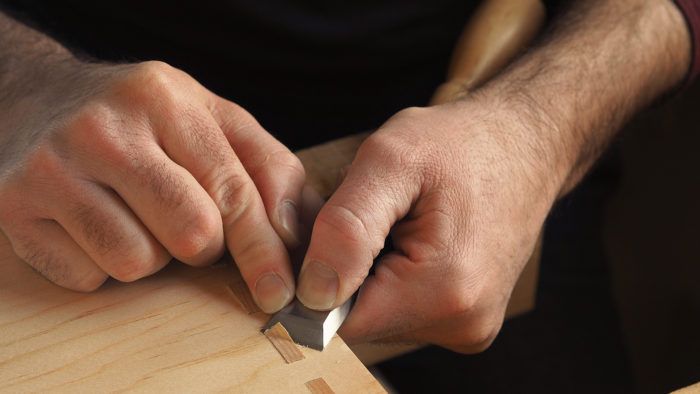Get a Big Chisel for Little Work
A 1-in. chisel is a great choice for paring and cutting small-scale joinery.

Synopsis: Often the best tool for a small job is a big chisel. Matt Kenney swears by his 1-in.-wide chisel for the delicate boxes and cabinets he makes. He uses it almost exclusively for paring. Sometimes this means using a jig to create a 45° miter on the side of a small box or bit of molding. At other times it is used to cut angles on the ends of the delicate pieces that make up a kumiko pattern. It’s also a great tool for flush trimming, and for paring the outside shoulders on tail boards when cutting dovetail joinery. From issue #267—Mar/Apr 2018
I have a 1-in.-wide chisel that I could not work without, because it helps me achieve the level of precision demanded by the small, delicate boxes and cabinets that I make. The chisel takes and holds a very keen edge and leaves a great surface behind. It has a nice, well-balanced heft. It’s wide enough to hold comfortably by the blade, near the bevel, which gives me far greater control over the chisel than holding it by the handle. More important than these individual qualities is that taken together, they form a tool that just works. I never have to struggle against any shortcomings. I can work more intuitively, and as a result, more efficiently and accurately. It’s a joy to use.
I use the chisel almost exclusively for paring. Sometimes this means using a jig to create a 45° miter on the side of a small box or bit of molding. At other times I use it to cut angles on the ends of the delicate pieces that make up a kumiko pattern. It’s also a great tool for flush trimming, and for paring the outside shoulders on tail boards when cutting dovetail joinery. One thing I never do is whack it with a mallet. Sure, it could be used to chop out waste from a dovetail or mortise, but for me it’s a refined tool, reserved for precision work.
My 1-in.-wide chisel is heavy, but this is a benefit, not a problem. Because the majority of the weight is in the blade, the chisel is easy to balance when held by the blade with both hands. The handle doesn’t droop, so it’s easy to keep the blade pressed firmly down on the reference face of a miter or kumiko jig, or when paring a part flush.
However, weight isn’t the only reason this chisel is great for paring. Its width makes it more stable than narrower chisels. As a result, this is an excellent tool for paring one part flush to another. Place the chisel flat on the reference surface, press it down with your off hand, and then push the chisel into the part you are trimming flush. This works best when there is very little material left to pare. If there’s 1⁄16 in. or more above the surface, then pare just a bit at a time. I do this by pressing the chisel down and then rotating the blade into the cut. You can accurately remove between 1⁄16-in.- and 1⁄8-in.-wide swaths of waste with this technique.
For the full article, download the PDF below.
More on FineWoodworking.com
- Bench Chisels – 23 brands go head to head in a real-world test
- Japanese Chisels – With proper preparation, these tools take and hold a superior edge
- 4 Chisel Tricks – From chamfering to shaping curved parts, a flat bench chisel is all you need
Fine Woodworking Recommended Products

Stanley Powerlock 16-ft. tape measure

Veritas Precision Square

Marking knife: Hock Double-Bevel Violin Knife, 3/4 in.








Log in or create an account to post a comment.
Sign up Log in